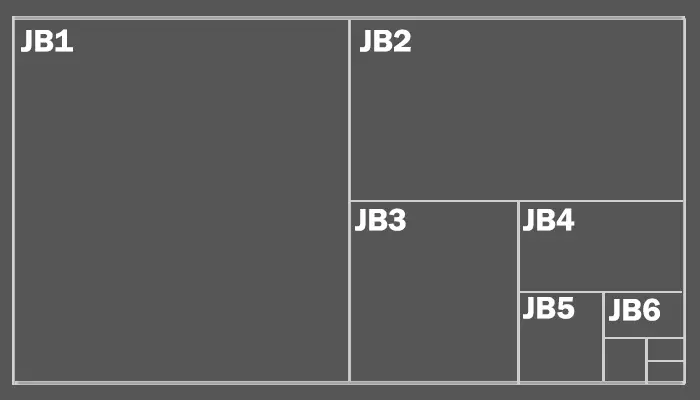This article is all about Japanese Paper Sizes and their in-depth parts.
Table of Contents
Standard Japanese Paper Sizes
The standardization for paper sizes in a country like Japan is done by the Japanese Industrial Standard Organization. This organization has defined two standard paper sizes: JIS A and JIS B. The JIS A standard has similarities with the ISO 216 A size, with minor differences. In contrast, the JIS B sizes significantly differ in size from the ISO 216 B as it has an area of 1.5 times the A size of paper than the root 2 times mentioned in ISO 2016.
Table for JIS B Paper Sizes From B0 to B10
| Size | Width x Height (mm) | Width x Height (in) |
|---|---|---|
| B0 | 1030 x 1456 mm | 40.6 x 57.3 in |
| B1 | 728 x 1030 mm | 28.7 x 40.6 in |
| B2 | 515 x 728 mm | 20.3 x 28.7 in |
| B3 | 364 x 515 mm | 14.3 x 20.3 in |
| B4 | 257 x 364 mm | 10.1 x 14.3 in |
| B5 | 182 x 257 mm | 7.2 x 10.1 in |
| B6 | 128 x 182 mm | 5.0 x 7.2 in |
| B7 | 91 x 128 mm | 3.6 x 5.0 in |
| B8 | 64 x 91 mm | 2.5 x 3.6 in |
| B9 | 45 x 64 mm | 1.8 x 2.5 in |
| B10 | 32 x 45 mm | 1.3 x 1.8 in |
Traditional Paper Sizes
Japan has certain types of Japanese paper sizes that the Japanese consider to be traditional. These are Shirokuban and Kiku. Also, many of the old printing mills and machines use these two paper sizes in Japan.
Shirokuban Sizes
| Length x Height (mm) | Length x Height (in) | Aspect Ratio |
|---|---|---|
| 264 x 379 mm | 10.39 x 14.92 in | 1:1.4356 |
| 189 x 262 mm | 7.44 x 10.31 in | 1:1.3862 |
| 127 x 188 mm | 5.00 x 7.40 in | 1:1.4803 |
Kiku Sizes
| Length x Height (mm) | Length x Height (in) | Aspect Ratio |
|---|---|---|
| 227 x 306 mm | 8.94 x 12.05 in | 1:1.3480 |
| 151 x 227 mm | 5.94 x 8.94 in | 1:1.5033 |
The paper size for Shirokuban is not fixed precisely, and it might vary from producer to producer.
See Also: –
- A Series Paper Size Areas – A0, A1, A2, A3, A4, A5, A6, A7, A8, A9, A10
- Billboard Sizes/Dimensions – Including Multisheet Billboards
Other Paper Sizes Found In Japan
Apart from Shirokuban and Kiku, people use many other paper sizes in Japan. The popular ones like the AB format, which has a short side of A4 and the longer side of B5. One another form is B40 which has the size of 80% of B5.
| Size | Length x Height (mm) | Length x Height (in) | Aspect Ratio |
|---|---|---|---|
| AB | 210 x 257 mm | 8.27 x 10.12 in | 1:1.2238 |
| B40 | 103 x 182 mm | 4.06 x 7.17 in | 1:1.7670 |
| Shikisen | 84 x 148 mm | 3.31 x 5.83 in | 1:1.7619 |
So, this was all about Japanese Paper Sizes.
FAQ’s
What paper size is there in Japan?
The Oban format, which employs half of a huge hosho sheet (O-basho) measuring around 21 x 15.5 in. (53 x 39.4 cm), is the most frequent print size. However, different recipes and molds are used by Japanese papermakers, and there is no clear standard for the size of a huge hosho sheet.
What makes Japanese paper unique?
Because of the increased strength of the fibers in Japanese paper, stock weights are much lighter than in wood pulp papers. Japanese paper is excellent for interleaving, surface restoration, surface protection, framing, and other conservation applications.
What is the significance of paper size?
Sizing applies to paper during manufacturing to limit the paper's ability to absorb liquid when dry and to allow inks and paints to remain on the paper's surface and dry there rather than being absorbed into the paper.
What is the optimal paper size?
The most popular traditional size formats are Letter (8.5 11 inches), Legal (8.5 14 inches), and Tabloid (11 17 inches). You almost certainly utilize these formats in your daily life. Letters are commonly used in commercial and academic publications.
What materials make Japanese paper?
What are the applications for Japanese paper?
Origami, kites, doll and umbrella manufacturing, and exquisite packaging are just a few of the historic applications of paper that have survived.
Which is the smallest paper size?
The smaller the number, the smaller the size of the paper - A10 is the smallest, and A0 is the largest. Besides Mexico, the Dominican Republic, the United States, and Canada, ISO 216 establishes the international standard for paper sizes.
Why is a sizing agent needed in the manufacture of paper?
Surface sizing agents are widely used to improve water resistance and to keep paper from blurring when wet or ink is there. These agents are in use on a wide range of paper and paperboard products (writing paper, copy paper, corrugated board, newspaper, postcards, paper cups, paper bags, and so on).
Which paper color is the best?
The light yellow and light blue paper is easiest to read off from. It was easy to read in all lighting circumstances, and the color's impact was not lessened if someone wore tinted glasses.
What kind of paper are Japanese students using?
Hosho is a high-quality, robust, and absorbent traditional paper. Handmade in Japan with 100% Sulphite Pulp that has been dried on stainless steel with no sizing. This Hosho paper is suitable for woodblock or lino printing and hinging prints for framing and lining spines in bookbinding.





